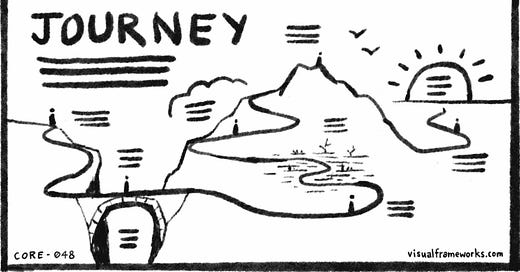The Monday memo is food for thought to fuel your week.
Hi everyone,
I’ve been inspired recently by Brad Didericksen, who has started an interesting practice that I want to share with you.
Recently I noticed that Brad’s writing had changed dramatically. Suddenly, almost overnight, it seemed that it had become more personal, more vulnerable, more relatable, more emotional, more human. So I asked him, hey Brad, how did you do that? And he said, I go for a walk, turn on a voice recorder, and talk to myself on the phone, just like I am talking to a close friend. He also told me that he makes a little grocery list of topics to carry with him, so he can remember what he wants to cover.
What's the benefit of walking and talking to yourself? Well, for one thing, walking is conducive to thought. I think it has something to do with having your body and mind somewhat occupied with moving around. Your body is occupied, your eyes are occupied, and somehow that unleashes a sort of free-floating stream of consciousness. You can just say whatever comes into your mind, knowing that you have the benefit of a recording and that you can edit it later.
There's nothing holding back the thoughts from streaming. There's no friction between your mind and your pen and your paper and no need to think about whether your fingers are hitting the right keys as you’re typing. You're just talking, like you're talking to a friend.
I haven’t done exactly this before, but I do have some experience of the difference between talking and writing and how it shows up in your written work. When I “wrote” my last book, Liminal Thinking, I created it by recording and transcribing conversations. I noticed that when I transcribed verbal dialogue, it just felt much more natural, much more conversational, much more like having a chat with a friend than my previous books: Less dry, more lively, more alive. Maybe that is something about oral traditions, that they feel more alive.
Conversation is different than writing formally. It builds on itself, and it kind of flows. Maybe that’s why they call it the stream of consciousness. And having a walk-and-talk with yourself is kind of like wandering alongside a meandering stream.
I’ve never done this before, so as an experiment, I tried doing it for today’s memo. It does feel a little bit weird when other people are walking by and you’re talking to yourself, but I do live in Portland, Oregon, and weird is totally acceptable here. In fact, it's expected. I tried it two ways, once with earbuds in and once holding the phone up to my ear. When I talked directly into my phone, holding it up to my ear, it definitely felt a little bit less weird.
Does this memo feel any different to you? It does to me, but I’m not sure yet if it’s better or worse.
Exercise.
Now, you can try this experiment for yourself. Just imagine a friend on the other end of the line. It could be someone who’s alive or someone who’s no longer with us, someone who you see all the time, or an old friend that you haven't spoken to in years.
Go for a walk and imagine them on the other end of the line, listening.
Have a chat with them, or if it feels easier, just talk to yourself. Record it. Get a transcript, see what it looks like. Chop it down, slice it up, rearrange it, edit it until it is clear and makes sense.
Do you see something that you don't usually see in your writing? Can you find something that's working and make it work better? Try it and see what happens.
Membership.
If you’re not a member yet, I hope you’ll join us in the project studio, where we work together to move our creative projects forward. In project studio we encourage each other, share ideas and inspiration, and push each other to do our best creative work.
If you’re already a member, thank you. You’re making this possible, and your membership is what gives me the confidence and encouragement to keep going.
More information for members is below the fold.




